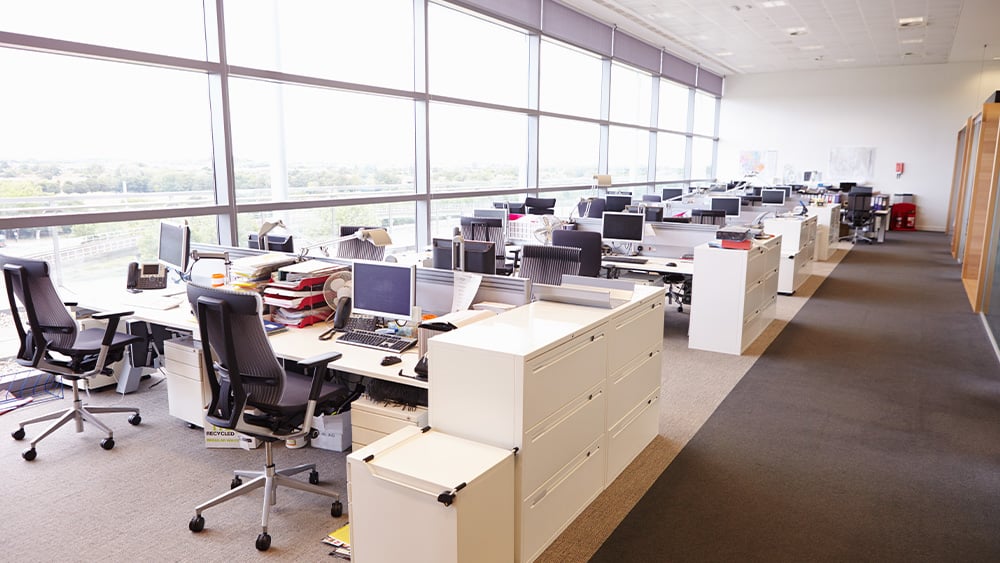Focus Areas for Effective COVID-19 Space Planning for Employee Reentry
June 24, 2020

COVID-19 remains an urgent health crisis across the United States and the globe, but there are signs of progress as many states, counties and local municipalities are beginning to open up as part of their respective recovery plans.
Essential businesses in the life sciences, construction, and in healthcare have been grappling with and adapting to social distance restrictions since the onset of the pandemic. Now, with nonessential workers on the precipice of being able to return to the office, companies are facing a new challenge: How to safely bring nonessential employees back into the physical office environment while maintaining productivity.
In a post-COVID world, telework will become entrenched and the norm. And coming into the office will be a targeted, purpose-driven event shaped by health and safety concerns more than social or collaboration needs.
This is the new normal that organizations are just beginning to confront and plan for when it comes to planning staff reentry to the brick-and-mortar office environment. If you are part of a task force creating the strategy and plans for reentry, here is what you need to focus on to ensure your physical workplace is as safe and productive as possible.
Phasing
It is important to phase or stage reentry. It is not advisable to have all of your staff return on one date under a single set of regulations.
Create a reentry strategy and plan that builds reentry opportunities based on actual, practical necessity and with regulations that will evolve as the pandemic recovery moves through its various phases.
- Consider beginning with a limited reentry phase for nonessential staff that is highly regulated, i.e., no amenities are open, temperature checks, and other restrictions. Use this as a testing phase to see what is feasible and effective, and run this phase for several weeks.
- Take what you’ve learned and apply it to the next phase of reentry, that will mirror the broader state of the pandemic in your region; so, if your region has moved into a different stage of recovery, perhaps your phase II is less restrictive than phase l with some amenities access, more staff allowed in the office, and the use of conference rooms at a reduced person capacity.
- The final phase of reentry will become your organization’s new normal. This will be your office’s post-COVID-19 reality that will benefit from what you’ve learned from the earlier phases and will parallel the state of your region’s pandemic recovery process.
The point is to take it slow, always keep safety and health top of mind, and apply what you learn along the way to make reentry pragmatic and productive.
Space Planning
The interior design of office space has evolved from private, large offices on the perimeter of a central area of open cube workstations to open-concept, communal and collaborative designs that are built for interaction and flexibility.
What will the post-COVID-19 office space look like? We don’t yet know, but you can be sure that large communal areas will be restricted in their use; flex collaboration spaces will be avoided for a time; and workstation sharing will not happen any longer.
The way staff use the office and move around within it has fundamentally changed and is continuing to change as organizations large and small begin to come back to the office.
Again, your reentry team needs to look at your office space with fresh eyes and with a focus on safety and health. The cafeteria should not be open in the early phases of reentry; conference rooms should not be used at first, and then can be used at half capacity. Even the type of furnishings in the office might need to be reconsidered depending on how easy they are to clean and disinfect.
What’s more, your team needs to create a signage and way-finding plan for employees reentering the workplace. All of this will be new and strange to them, and making it as easy as possible to follow the new normal rules is critical to keeping everyone safe.
- Place markers on the floor indicating six feet of separation
- Create instructions for using the coffee makers, for example
- Add posters to remind your staff of COVID-19 protocols
- Create hand sanitizer stations throughout the office
- Create access to personal protective equipment (PPE) and post rules for their use and disposal
No one understands yet how to operate in a physical office environment. It’s up to your reentry planning team to create a plan and educate your staff every day so that they can comply consistently.
HVAC and Circulation
Ventilation and air circulation in your office space need to be examined as part of the reentry plan. If you have an outdated HVAC system and poor air circulation, this could increase safety risks for your staff. By keeping air circulating properly with a mix of air from inside and outside, viruses in general become diluted and are less able to spread via the ventilation system.
Also, leveling off the amount of humidity in the air can be an effective way to reduce the possibility of viral spread. According to a recent article in the Verge, “Viruses don’t survive as well when humidity inside a building hovers around 50 or 60 percent. When humidity is too low or too high, the influenza virus can spread more easily, for example. In schools and offices, people report fewer respiratory infections and take fewer sick days when humidity is kept in a middle range.”
It is widely accepted that the way we work has changed irrevocably. More employees will telework. Fewer employees at any given time will be in the physical office environment. Office use will be restricted. And other, unforeseen implications may yet reveal themselves as companies move through the reentry process.
No one quite knows how COVID-19 will impact the future of brick-and-mortar offices or the design and construction of physical office spaces in the future.
What we do know is this: Your company needs to be thoughtful, strategic, and deliberate planning staff reentry to keep your staff safe and your company operating at full force in the post-COVID-19 new normal.




